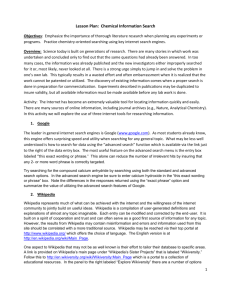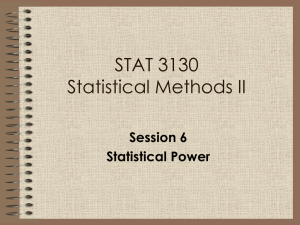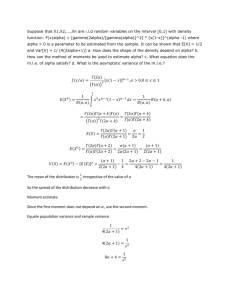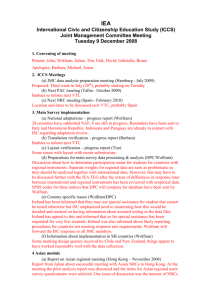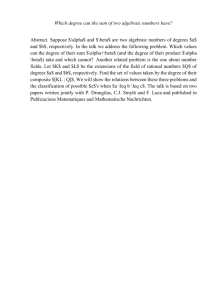Wolfram Alpha Examples M071 Wolfram alpha is available at http
advertisement
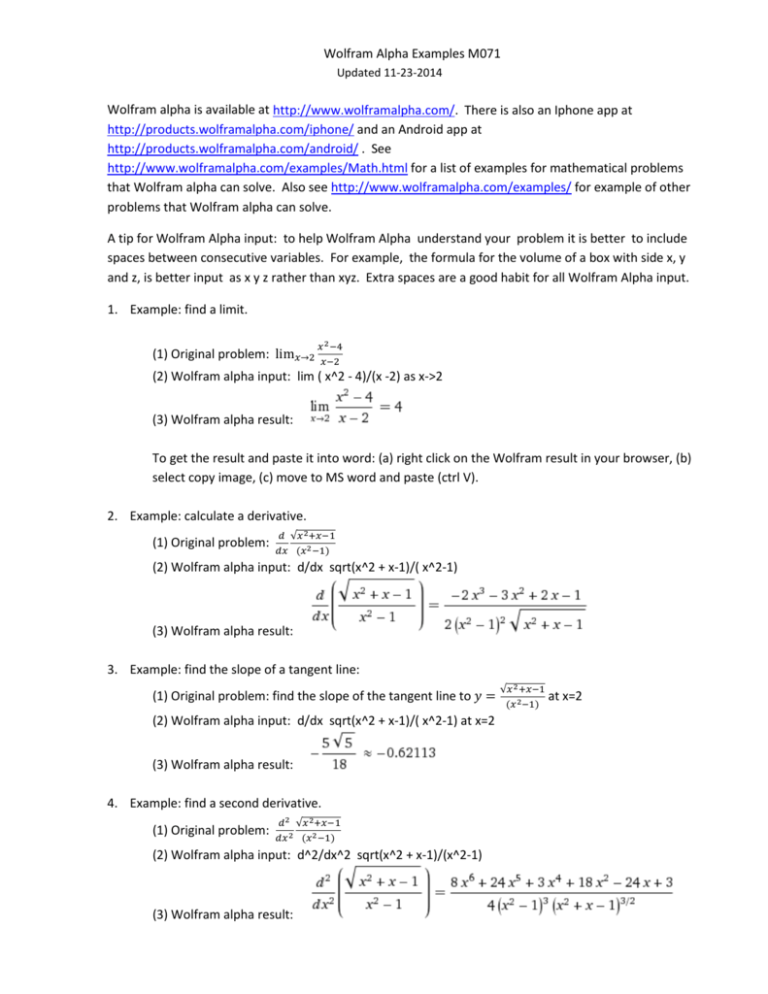
Wolfram Alpha Examples M071 Updated 11-23-2014 Wolfram alpha is available at http://www.wolframalpha.com/. There is also an Iphone app at http://products.wolframalpha.com/iphone/ and an Android app at http://products.wolframalpha.com/android/ . See http://www.wolframalpha.com/examples/Math.html for a list of examples for mathematical problems that Wolfram alpha can solve. Also see http://www.wolframalpha.com/examples/ for example of other problems that Wolfram alpha can solve. A tip for Wolfram Alpha input: to help Wolfram Alpha understand your problem it is better to include spaces between consecutive variables. For example, the formula for the volume of a box with side x, y and z, is better input as x y z rather than xyz. Extra spaces are a good habit for all Wolfram Alpha input. 1. Example: find a limit. (1) Original problem: lim𝑥→2 𝑥 2 −4 𝑥−2 (2) Wolfram alpha input: lim ( x^2 - 4)/(x -2) as x->2 (3) Wolfram alpha result: To get the result and paste it into word: (a) right click on the Wolfram result in your browser, (b) select copy image, (c) move to MS word and paste (ctrl V). 2. Example: calculate a derivative. (1) Original problem: 𝑑 √𝑥 2 +𝑥−1 𝑑𝑥 (𝑥 2 −1) (2) Wolfram alpha input: d/dx sqrt(x^2 + x-1)/( x^2-1) (3) Wolfram alpha result: 3. Example: find the slope of a tangent line: (1) Original problem: find the slope of the tangent line to 𝑦 = (2) Wolfram alpha input: d/dx sqrt(x^2 + x-1)/( x^2-1) at x=2 (3) Wolfram alpha result: 4. Example: find a second derivative. (1) Original problem: 𝑑 2 √𝑥 2 +𝑥−1 𝑑𝑥 2 (𝑥 2 −1) (2) Wolfram alpha input: d^2/dx^2 sqrt(x^2 + x-1)/(x^2-1) (3) Wolfram alpha result: √𝑥 2 +𝑥−1 (𝑥 2 −1) at x=2 5. Example: solving systems of equations. x+ y+z+w=6 x + 2 y + 4 z + 3w = 15 2 x + y + 3 z − w = 14 (1) Original problem: solve the system: 3 x − 2 y + z + 5w = 24 (2) Wolfram Alpha input: solve( x+y+z+w = 6, x+2y+4z+3w = 15, 2x+y+3z-w = 14, 3x-2y+z+5w = 24 ) (3) Wolfram Alpha result: There is a unique solution. Be careful Wolfram Alpha puts the variables in alphabetical order so w is listed first. 6. Example: critical numbers. (1) Original problem: Find the critical numbers of 𝑓(𝑥) = 2𝑥 3 − 9𝑥 2 (2) Wolfram alpha input: d/dx 2 x^3-9 x^2 (3) Wolfram alpha result (scroll down to Roots): and It was necessary to use copy image twice on the Wofram alpha page, once for each root, and to paste each root to this word document. 7. Example: draw a plot of a function. (1) Original problem: draw a plot of the function 𝑓(𝑥) = 2𝑥 3 − 9𝑥 2 (2) Wolfram alpha input: 2 x^3-9 x^2 (3) Wolfram alpha result (scroll down to Plots): 8. Example: indefinite integral 𝑒𝑥 (1) Original problem: find the indefinite integral ∫ 1+𝑒 𝑥 𝑑𝑥 (2) Wolfram alpha input: integral exp(x) / ( 1 + exp(x)) dx (3) Wolfram alpha result: 9. Example: definite integral 2 𝑒𝑥 𝑑𝑥 1+𝑒 𝑥 (1) Original problem: find the indefinite integral ∫0 (2) Wolfram alpha input: integral exp(x) / ( 1 + exp(x)) dx, x= 0 .. 2 (3) Wolfram alpha result: 10. Example: plot a surface and a contour plot (1) Original problem: draw a plot of the surface 𝑓(𝑥, 𝑦) = 2𝑥 3 + 𝑥𝑦 2 + 5𝑥 2 + 𝑦 2 in 3 dimensions and draw a contour plot in 2 dimensions (2) Wolfram alpha input: 2 x^3+x y^2+5 x^2+y^2 (3) Wolfram alpha result (scroll down to and copy 3 D plot and Contour plot) 11. Example: partial derivatives (1) Original problem: evaluate 𝜕2 𝑓 𝜕𝑥𝜕𝑦 of 𝑓𝑥𝑦 for 𝑓(𝑥, 𝑦) = 𝑥 𝑒 𝑥+𝑦 (2) Wolfram alpha input: d/dx d/dy x exp(x+y) (3) Wolfram alpha result: 12. Example: solution to a Lagrange multiplier problem (1) Original problem: use Lagrange multipliers to maximize V = x y z subject to the constraint 6𝑥 + 4𝑦 + 3𝑧 − 24 = 0. See the example on page 958 of Larson and Hodgkins. Instead of the Greek letter λ we use the English w. We present three different ways to solve the problem. More background discussion of these three solutions is in the document titled “Lagrange Multiplier Examples” at http://www.math.sjsu.edu/~foster/m071/m071fall12.html . First Solution: Solve the Lagrange equations (the equations obtained by setting all partial derivatives of F(x,y,z,w) = x y z – w ( 6 x +4 y+3 z – 24) to zero.) Wolfram Alpha Input: solve y z - 6w = 0, x z-4w = 0, x y – 3 w = 0, -6 x – 4 y – 3 z + 24 = 0 Wolfram Alpha Result: The correct answer to the maximization problem is the last solution since this solution, with x = 4/3, y = 2 and z = 8/3, has V = 64/9 which is larger than V values (= 0) for the other solutions. OR Second Solution: find a stationary point of the Lagrange function F. A stationary point is a point where all the partial derivatives of a function are zero. (2) Wolfram alpha input (note the space between the w and the left parenthesis is required): stationary points of x y z – w ( 6 x +4 y+3 z – 24) (3) Wolfram alpha result: Substituting each of the four possible (x,y,z) values into V, we see that V=(4/3)(2)(8/3)=64/9 is the maximum value of V. OR Third Solution: solve a constrained optimization problem. In the problem we want to maximize xyz subject to the constraint that 6 x + 4 y + 3 z − 24 = 0, Implicit in the problem are additional constraints that x ≥ 0, y ≥ 0, z ≥ 0 since V is the volume of a box and the box must have sides with non-negative length. (2) Wolfram Alpha input: maximize x y z subject to 6 x + 4 y + 3 z - 24 = 0, x >= 0, y >= 0, z >= 0 (3) Wolfram Alpha result: Here the ∧ is Wolfram Alpha’s symbol for “and.”
